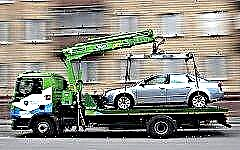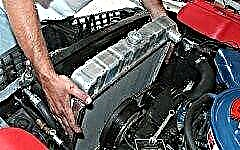

The content of the article:
- Causes of cooling radiator malfunctions
- Typical malfunctions
- How to pinpoint a radiator leak
- Repair methods
After the fuel is burned in the engine, about 70% of the generated energy is converted into heat. Some of the heat goes out through the exhaust pipe, but most of the heat stays inside the engine, heating it to a high temperature.
A cooling radiator (heat exchanger) is used to prevent engine overheating and dissipate heat into the environment, which is the main component of the vehicle's cooling system. A healthy and well-maintained (clean) radiator maintains optimum operating temperature in the engine, allowing it to run at full capacity.
However, the radiator, like all other elements of the car, can fail and stop performing its function. But at the same time, it is not at all necessary to immediately contact a car service for repairs. As practice shows, in most cases, a heat exchanger malfunction can be eliminated independently. To do this, you just need to identify the cause of the breakdown and know how to eliminate it.
Causes of cooling radiator malfunctions

There are not so many reasons causing problems with the radiator, and conditionally they can be divided into three types:
- mechanical damage;
- improper operation;
- normal wear and tear during operation.
You can also add a factory defect, but this reason is extremely rare. In most cases, the above reasons lead to one consequence - a violation of the tightness of the radiator. That is, it simply starts to leak.
But there is another "result" of breakdown, which can be more likely attributed to improper operation - fouling of heat transfer plates... Simply put, the radiator becomes so dirty that it stops exchanging heat with the environment, since an adhered and dried layer of dirt (dust, insects, poplar fluff) prevents heat from separating from the heat exchange plates.
In this situation, it is hardly appropriate to talk about repairs, because the problem is solved by simply flushing the radiator fins with a stream of running water. By the way, dirt can form not only outside the radiator, but also inside it in the form of blockages, scale and corrosive deposits.
Mechanical damage
A small stone that accidentally flew out from under the wheel of a car, as well as a serious accident with a head-on collision, can damage the radiator mechanically with the subsequent violation of the tightness. Also, the inept maintenance of the radiator by an inexperienced car owner, when he accidentally damages the housing, heat exchange elements or other parts, can also be attributed to mechanical damage.
Incorrect operation
Incorrect operation can consist not only in untimely cleaning and washing of the radiator, but also in the use of low-quality coolant.
Poor quality of the liquid can lead to its freezing and "defrosting" of the radiator, even with a slight frost, with a subsequent violation of the tightness. Or the composition of a low-quality liquid may be so aggressive that it corrodes metal. And this eventually leads to the same defect - depressurization and leaks.
Normal wear and tear during operation
In a car, as in other technology, there is nothing eternal. And the cooling radiator is no exception. He and its related parts are also subject to corrosion, destruction, blockages during operation.
Typical cooling radiator malfunctions

Typical radiator malfunctions can be divided into two types: external and internal.
External:
- violation of the tightness of the pipes for the delivery of coolant to the radiator tanks;
- the formation of cracks on the radiator tubes for the supply / removal of coolant;
- violation of the tightness of rubber seals.
Internal:
- the formation of blockages in the conductive tubes that prevent sufficient cooling of the liquid.
How to pinpoint a radiator malfunction (leak)

Before starting to repair the radiator, you need to determine the nature and location of the malfunction itself. Almost all external malfunctions of the radiator (except for the usual pollution) consist in a violation of its tightness, which means that there must be a coolant leak.
It is possible to detect the fact of fluid leakage from the radiator by carefully examining the device itself and the place under it. However, the first sign of a radiator leaking is usually not traces of leaked liquid, but a drop in the coolant level in the expansion tank.
The intensity of fluid flow from the radiator can be different, and at the initial stage it is visually imperceptible, but a rapid decrease in the level of fluid in the tank is noticed almost immediately. After all, a decrease in the level of antifreeze or antifreeze leads to overheating of the engine, which will be immediately signaled by a special temperature sensor on the driver's instrument panel.
There are two ways to pinpoint the location of a fluid leak. In this case, you will need to completely drain the coolant from the radiator, and disconnect the radiator itself, remove it from the car and rinse thoroughly.
- It is necessary to plug (close) all radiator inlets and leave only one. Pour water into the radiator through the left hole. Through the same open hole, using a pump or compressor, create excess pressure in the radiator. A stream of water will begin to come out of the hole in the damaged area.
- Also, the removed, empty and clean radiator, but with all the inlets plugged, should be completely immersed in a suitable container of water. Air bubbles will emerge from the holes in damaged areas. If air does not come out, create excess pressure in the radiator with a pump or compressor.
Cooling radiator repair methods

There are several ways to repair a radiator, but not all of them are available and are suitable for independent "garage" or "field" repair. Below we will consider the most simple and common methods of self-repair in simple conditions, without special professional equipment.
Radiator repair with sealants
External repair with sealant
For exterior repair of a cooling radiator, a heat-resistant adhesive sealant with metal powder is often used. Such a composition is often called "cold welding" or "metal sealant". On the market, such sealants can be offered ready-to-use or as separate components, which then need to be mixed until a homogeneous mass is obtained.
Repairing a radiator using an external glue sealant is quite effective, but only subject to compliance with the relevant technological requirements at each stage of work:
- the coolant must be completely drained from the radiator;
- the outer surface intended for repair must be thoroughly degreased and lightly processed with a file or emery cloth until a slightly rough surface is formed;
- for sealing large holes (more than 2 mm), metal patches with a degreased and treated surface can be used.
A sealant is applied around the hole (crack). Initial hardening occurs within 2-3 minutes, and complete hardening within 24 hours. The product can be used after 24 hours.
The advantage of a metal sealant is that its coefficient of thermal expansion is close to the coefficient of metal, and if everything is done correctly, then the sealed radiator can serve for several more years.
Internal repair with chemical sealant
"Chemical sealants" are sometimes also referred to as "radiator reconditioning fluid" or "powder reducing agent". Accordingly, such sealants are powder and liquid.
Immediately, we note that with the help of a chemical sealant with pouring into the radiator, only minor leaks (no more than 2 mm) can be eliminated and only temporarily. In fact, this is an emergency measure to reach the garage or service station.
Eliminating a leak with a sealant (from the inside) is not a difficult process. The sealant is poured into the cooling system, after which it comes into contact with air and creates a polymer plug that clogs the hole at the leak.
However, this method has a serious drawback - the sealant clogs the cooling system., after which a complete flushing of the system (and an air conditioner with a stove too) is required. Therefore, the internal use of a sealant is advisable only in an emergency, when the leak is urgently needed to be repaired. You can drive with such a sealant no more than 100 km.
Repair of cooling radiators using a soldering iron (soldering)
Repairing radiators using soldering is considered not only more reliable, but also more difficult and time consuming. However, this self-repair method is not suitable for all radiators. For example, it is better not to use it to repair radiators made of aluminum alloys, which are very difficult to repair under normal conditions. It is better, easier and faster to seal such radiators with metal sealant. Brass devices are considered the most suitable for home repair with a soldering iron.
Repairing brass radiators with a soldering iron
To solder a brass radiator you will need:
- soldering iron with a power of at least 50 W;
- soldering acid (solution of acid and zinc) - for cleaning metal from oxide;
- borax powder (flux) - to neutralize the oxide film and better spreading of liquid solder;
- solder.
- metal brush, sandpaper or file.
The surface for applying the joint layer must be pre-cleaned from dirt and dust. Signs of corrosion and oxidation are removed with a wire brush. The working surface is treated with an emery cloth (or a file) to a shine, to improve the adhesion (adhesion) of the metal to the solder. The soldering iron tip must be clean and free of old solder and scale. The work surface must be warmed up immediately before soldering.
First, a thick layer of flux is applied to the damaged surface, then liquid solder is distributed over this surface with the flux with a soldering iron. Soldering is recommended to be performed in a circular motion, as if rubbing liquid solder into the crack (hole).
Important! Soldering can only be carried out at a certain distance from the factory seam, since brass has a high thermal conductivity and can melt the factory seam.
The process of soldering a radiator is not as easy as it seems at first glance. If you do not have sufficient minimum skills to work with a soldering iron or you are not confident in your abilities, then it is better to contact a specialist.
Repair of a radiator by plugging damaged pipes
If the cooling radiator has extensive damage, but at the same time it is localized (that is, it is located in one place), then the problem can be solved by plugging the damaged pipes.
Usually, the damaged tubes are tightly squeezed (flattened) with pliers on both sides as close as possible to the damaged area. In this simple way, the leakage of coolant from the defective holes is blocked.
As a rule, such radical actions are taken in "field" conditions when there is no other way out of the situation. It should be remembered that it is impossible to operate the car for a long time after such a radical repair, and the number of plugged tubes should not exceed 3-4 pieces.
Conclusion
The most recent car models are increasingly equipped with cooling radiators with plastic barrels and an aluminum alloy center section. It should be remembered that it is not necessary to waste time on the repair of such radiators, since they cannot be repaired at all - they must be changed immediately.











